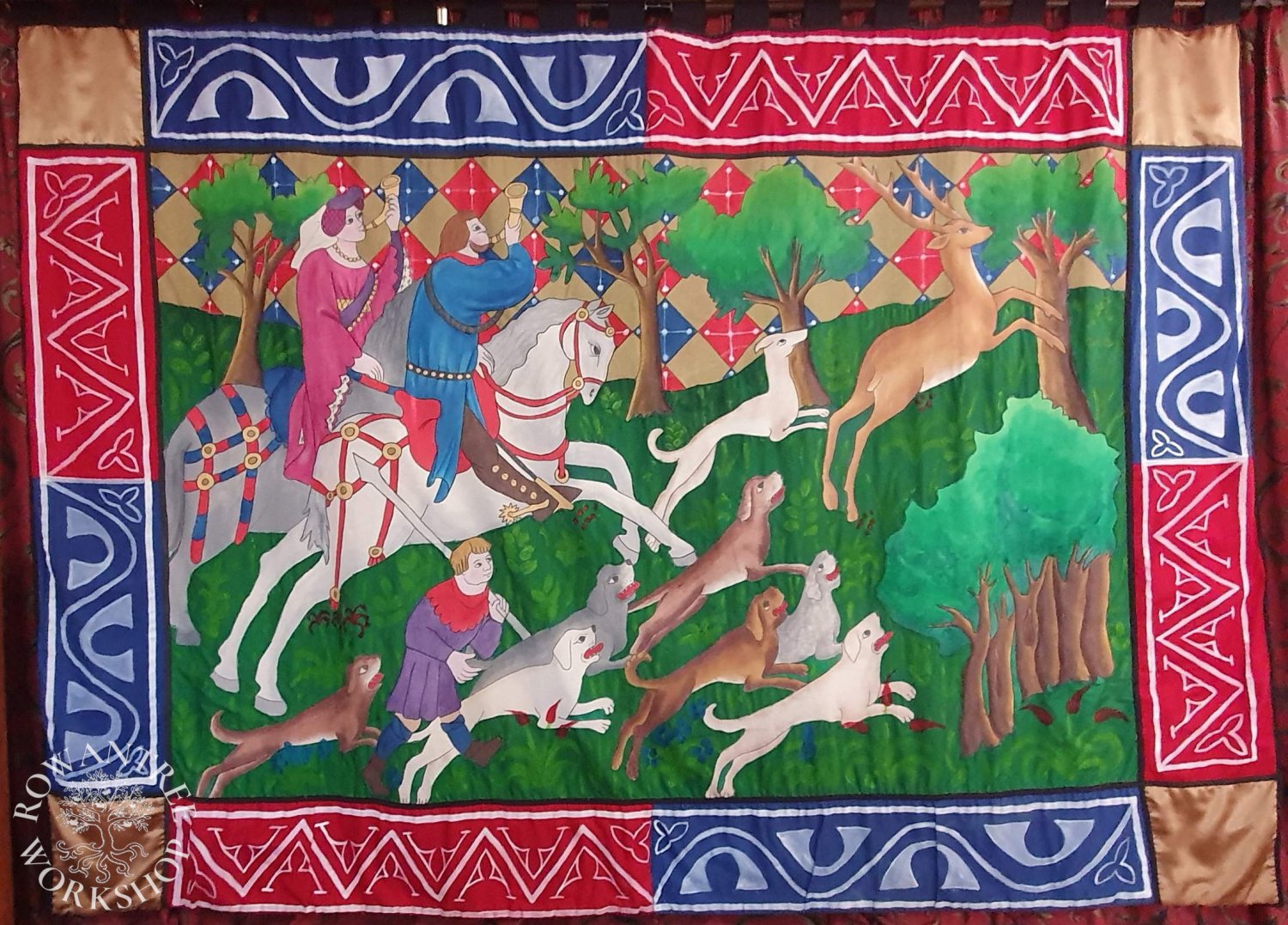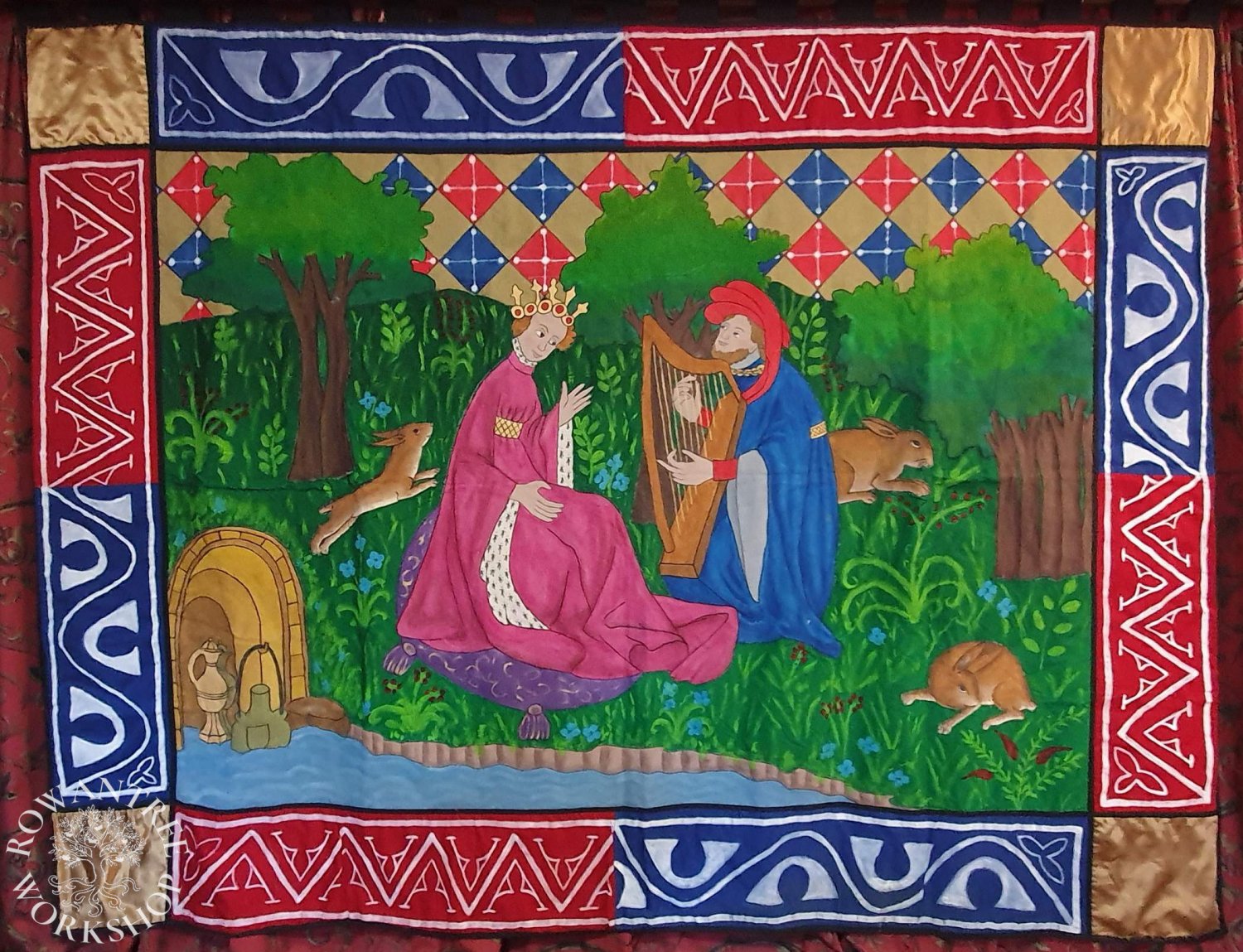A pair of painted hangings, in the style of 15th century illuminations.
As part of the preparations for Purgatorio 1994 (a large medieval event), my friend Yseult and I planned a series of four large scale painted hangings, based on the 15th century Book of the Hunt (Livre de chasse de Gaston Phébus). Since we were short on time (of course) we only managed two of them.

Research and Design
Despite the bare stone walls that most medieval castles and houses present today, in their heyday they were awash with colour. The walls themselves were often painted, or were covered in bright textiles, or both! Medieval & Renaissance Interiors (Oledzka 2016) notes that rich had expensive woven tapestries, which they carried with them when they travelled between their estates, along with other moveable furniture. They were an essential part of making rooms liveable.
The less well-off had simpler woven textiles, which might be painted in imitation of the richer ones. Even the rich might have painted textiles on their walls:
The linen material painted with the story of Bacchus [panno lino depintovi l’historia Bacho] that was fixed around the walls of an anticamera at the Medici residence at Fiesile in 1498
The Italian Renaissance Interior 1400-1600 (Thornton 1991, p48)
In Il Libro dell’Arte, Cenini describes how to make such hangings:
Also, for the painted hangings, you may cut white cloth, and put it on top of the blue cloth, fastening it on with pastes like glue; and lay it on according to the figures which you wish to distribute over the ground; and you may paint with washes of colour, without varnishing afterwards. And you get more done, and cheaply, and they are handsome enough at the price.
The Craftsman’s Handbook (Thompson 1960, p105)
The designs for these hanging were inspired by the Book of the Hunt (Livre de chasse de Gaston Phébus – BNF Fr616). Although medieval hangings (even painted ones) would not have included a border in this illumination style, I chose to make this part of the design.
Since the original plan was to have four hangings showing the same couple in different settings, I adapted the hunting design to show a man and a woman, and borrowed some elements from several illuminations for the picnic scene.
Construction
The hangings are 2.5m x 1.8m. To scale up the images, I photocopied the selected manuscript illuminations up to A4 size, traced the elements I wanted, then completed the design. I traced over them onto an acetate sheet, to make a transparency.


I used an overhead projector to project the design onto heavy sheeting, taped up to a wall, and traced over it in pencil. I took it off the wall and outlined in waterproof marker.
The grass in medieval illuminations is always shaded – dark green at the top/background, lighter to the base/foreground. I thought painting the grass with the shaded greens would be too much work, so I dip-dyed another sheet to get a graduated green fabric. I pinned the drawn layer over the green layer, then machine sewed around the figures using a small zig-zag. Then I cut the background part away with scissors, leaving a graduated green background and the figures, sky and trees in white.
Yseult and I painted the figures with fabric paints, using brushes and sponges to get the shading. We added foliage to the green background and finishing details.
For the borders, I cut strips of red and blue cloth, and we painted on the white line decoration. I sewed these onto the panels, with gold satin in the corners. I sewed black bias binding over the joins, then backed the whole hanging with black cotton, adding tabs along the top for hanging.

The hangings were a great success, and have been much used ever since. One hangs on the wall behind my bed to this day.

Afterthoughts
If I was doing these again, I would just paint the background on and not go through the whole dye and sew process. I don’t think it saved any time, and the edges of the appliquéd bits remained fuzzy, no matter how well trimmed.
The overhead projector is a great way to scale up images for hangings. Printing the design direct to the plastic sheet (rather than tracing) would speed the process even more.

